#review new york times
Explore tagged Tumblr posts
Text
‘Cabaret’ Review: What Good Is Screaming Alone in Your Room?
Eddie Redmayne and Gayle Rankin star in a buzzy Broadway revival that rips the skin off the 1966 musical.
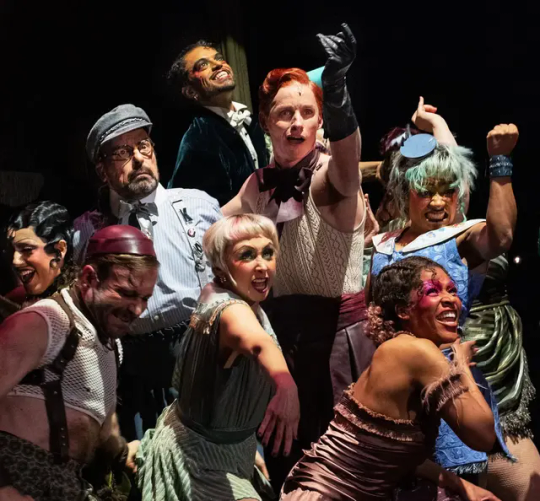
Eddie Redmayne, center, as the Emcee in Rebecca Frecknall’s revival of “Cabaret” at the August Wilson Theater in Manhattan.Credit...Sara Krulwich/The New York Time
By Jesse Green April 21, 2024
Just east of its marquee, the August Wilson Theater abuts an alley you probably didn’t notice when last you were there, perhaps to see “Funny Girl,” its previous tenant. Why would you? Where the trash goes is not usually part of the Broadway experience.
But it is for the latest revival of “Cabaret,” which opened at the Wilson on Sunday. Audience members are herded into that alley, past the garbage, down some halls, up some stairs and through a fringed curtain to a dimly lit lounge. (There’s a separate entrance for those with mobility issues.) Along the way, greeters offer free shots of cherry schnapps that taste, I’m reliably told, like cough syrup cut with paint thinner.
Too often I thought the same of the show itself.
But the show comes later. First, starting 75 minutes beforehand, you can experience the ambience of the various bars that constitute the so-called Kit Kat Club, branded in honor of the fictional Berlin cabaret where much of the musical takes place. Also meant to get you in the mood for a story set mostly in 1930, on the edge of economic and spiritual disaster, are some moody George Grosz-like paintings commissioned from Jonathan Lyndon Chase. (One is called “Dancing, Holiday Before Doom.”) The $9 thimbleful of potato chips is presumably a nod to the period’s hyperinflation.
This all seemed like throat clearing to me, as did the complete reconfiguration of the auditorium itself, which is now arranged like a large supper club or a small stadium. (The scenic, costume and theater design are the jaw-dropping work of Tom Scutt.) The only relevant purpose I can see for this conceptual doodling, however well carried out, is to give the fifth Broadway incarnation of the 1966 show a distinctive profile. It certainly does that.
The problem for me is that “Cabaret” has a distinctive profile already. The extreme one offered here frequently defaces it.
Let me quickly add that Rebecca Frecknall’s production, first seen in London, has many fine and entertaining moments. Some feature its West End star Eddie Redmayne, as the macabre emcee of the Kit Kat Club (and quite likely your nightmares). Some come from its new New York cast, including Gayle Rankin (as the decadent would-be chanteuse Sally Bowles) and Bebe Neuwirth and Steven Skybell (dignified and wrenching as an older couple). Others arise from Frecknall’s staging itself, which is spectacular when in additive mode, illuminating the classic score by John Kander and Fred Ebb, and the amazingly sturdy book by Joe Masteroff.

In this production, Gayle Rankin’s Sally Bowles is meant to be taken medicinally and poisonously, projecting instead of concealing her character’s turmoil, our critic writes.Credit...Sara Krulwich/The New York Times
But too often a misguided attempt to resuscitate the show breaks its ribs.
The conception of Sally is especially alarming. As written — and as introduced in the play and stories the musical is based on — she is a creature of blithe insouciance if not talent, an English good-time gal flitting from brute to brute in Berlin while hoping to become a star. Her first number, “Don’t Tell Mama,” is a lively Charleston with winking lyrics (“You can tell my brother, that ain’t grim/Cause if he squeals on me I’ll squeal on him”) that make the Kit Kat Club audience, and the Broadway one too, complicit in her naughtiness.
Instead, Frecknall gives us a Sally made up to look like she’s recently been assaulted or released from an asylum, who dances like a wounded bird, stretches each syllable to the breaking point and shrieks the song instead of singing it. (Goodbye, Charleston; hello, dirge.) If Rankin doesn’t sound good in the number, nor later in “Mein Herr,” interpolated from the 1972 film, she’s not trying to. Like the cough syrup-paint thinner concoction, she’s meant to be taken medicinally and poisonously in this production, projecting instead of concealing Sally’s turmoil.
That’s inside-out. The point of Sally, and of “Cabaret” more generally, is to dramatize the danger of disengagement from reality, not to fetishize it.
The guts-first problem also distorts Redmayne’s Emcee, but at least that character was always intended as allegorical. He is the host to anything, the amoral shape-shifter, becoming whatever he must to get by. Here, he begins as a kind of marionette in a leather skirt and tiny party hat, hiccupping his way through “Willkommen.” Later he effectively incarnates himself as a creepy clown, an undead skeleton, Sally’s twin and a glossy Nazi.
Having seen Frecknall’s riveting production of “Sanctuary City,” a play about undocumented immigrants by Martyna Majok, I’m not surprised that her “Cabaret” finds a surer footing in the “book” scenes. These are the ones that take place in the real Berlin, not the metaphorical one of the Kit Kat Club. She is extraordinarily good when she starts with the naturalistic surface of behavior, letting the mise en scène and the lighting (excellent, by Isabella Byrd) suggest the rest.
And naturalism is what you find at the boardinghouse run by Fräulein Schneider (Neuwirth), a woman who has learned to keep her nose down to keep safe. Her tenants include a Jewish fruiterer, Herr Schultz (Skybell); a prostitute, Fräulein Kost (Natascia Diaz); and Clifford Bradshaw (Ato Blankson-Wood), an American writer come to Berlin in search of inspiration. Soon Sally shows up to provide it, having talked her way into Cliff’s life and bed despite being little more than a stranger. Also, despite Cliff’s romantic ambivalence; over the years, the character has had his sexuality revamped more times than a clownfish.
The Schneider-Shultz romance is sweet and sad; neither character is called upon to shriek. And Rankin excels in Sally’s scenes with Cliff, her wry, frank and hopeful personality back in place. The songs that emerge from the boardinghouse dramas are not ransacked as psychiatric case studies but are rather given room to let comment proceed naturally from real entertainment. Rankin’s “Maybe This Time,” with no slathered-on histrionics, is riveting. It turns out she can properly sing.

The interface between the naturalism and the expressionism does make for some weird moments: Herr Schultz, courtly in a topcoat, must hug Sally goodbye in her bra. But letting the styles mix also brings out the production’s most haunting imagery. The intrusion of the Nazi threat into the story is especially well handled: first a gorgeously sung and thus chilling version of “Tomorrow Belongs to Me,” then the swastika and then — well, I don’t want to give away how Frecknall stages the scene in which Schultz’s fruit shop is vandalized.
That so many of these moments arise from faithful attention to the original material should be no surprise. “Cabaret” hasn’t lasted this long for nothing. Created at the tail end of Broadway’s Golden Age, it benefited from the tradition of meticulous craftsmanship that preceded it while anticipating the era of conceptual stagings that followed.
All this is baked into the book, and especially the score, which I trust I admire not merely because I worked on a Kander and Ebb show 40 years ago. That the lyrics rhyme perfectly is a given with Ebb; more important, they are always the right words to rhyme. (Listen, in the title song, for the widely spaced triplet of “room,” “broom” and, uh-oh, “tomb.”) And Kander’s music, remixing period jazz, Kurt Weill and Broadway exuberance, never oversteps the milieu or outpaces the characters even as it pushes them toward their full and sometimes manic expression.
When this new “Cabaret” follows that template, it achieves more than the buzz of chic architecture and louche dancing. (The choreography is by Julia Cheng.) Seducing us and then repelling us — in that order — it dramatizes why we flock to such things in the first place, whether at the Kit Kat Club or the August Wilson Theater. We hope, at our risk, to forget that, outside, “life is disappointing,” as the Emcee tells us. We want to unsee the trash.
Cabaret At the August Wilson Theater, Manhattan; kitkat.club. Running time: 2 hours 45 minutes, with an optional preshow.
Jesse Green is the chief theater critic for The Times. He writes reviews of Broadway, Off Broadway, Off Off Broadway, regional and sometimes international productions. More about Jesse Green
https://www.nytimes.com/2024/04/21/theater/cabaret-review-eddie-redmayne.html
#eddie redmayne#cabaret#cabaret nyc#review new york times#broadway#eddie redmayne cabaret#cabaret nwe production#august wilson#theatre#cabaret 2024#musical#cabaret musical
10 notes
·
View notes
Text
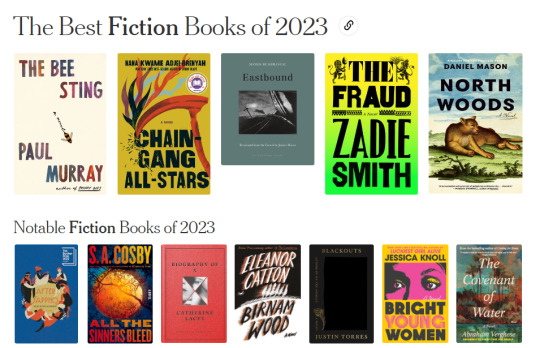
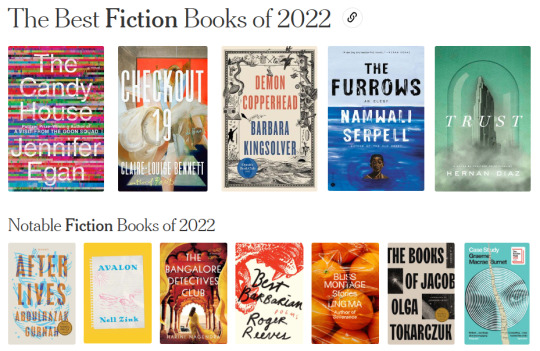
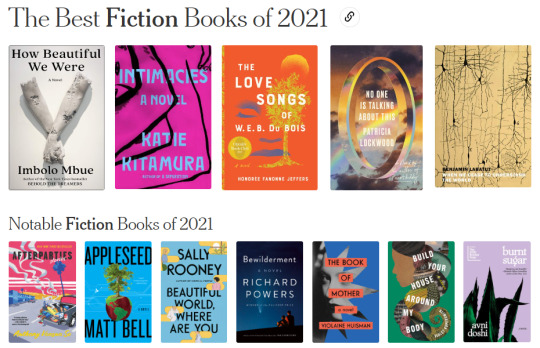
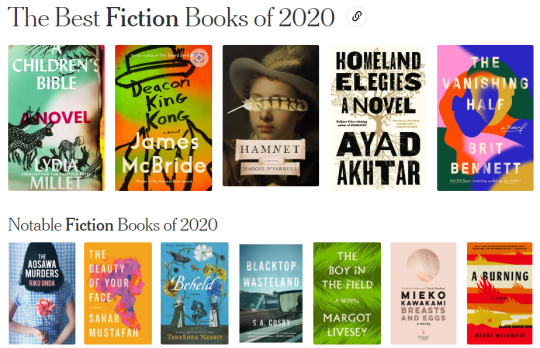
According to the New York Times, these are the best fiction books of the 2020s. Do you agree? What's missing?
546 notes
·
View notes
Text
The New York Times Review:
The Broadway revival of “Romeo + Juliet” plays to the TikTok crowd. But maybe that’s a good thing.
Source: New York Times Oct 24, 2024 (X)
Mostly positive, which is impressive from the NYT! Hopefully offsets the negative reviews. (X)

Kit Connor and Rachel Zegler and a viral pull-up
…Connor needs no help in keeping and maintaining the emotional temperature, easily enlarging the tenderness and obliviousness of his Nick on “Heartstopper” to fit the stage. When he looks into Juliet’s eyes, you see what he wants and how seriously he wants it; when he walks among his riotous peers, as they hump Teddy bears and sniff out insults, you see how little that means to him now.
Connor is also a very physical actor, or at any rate his recently beefed-up, often tank-topped body is given a workout. Instead of just climbing to Juliet’s balcony — represented by the design collective dots as a flowery bed that descends from the heavens — he does a leaping pull-up from the ground to get there, then lifts himself farther to achieve full face time. This is a lover with lats.

But a manly Romeo and a tiny Juliet — Connor is nearly a foot taller than Zegler — creates, or reinforces, a problem. It’s disturbing enough in the Shakespeare when Lady Capulet tells her 13-year-old daughter that “ladies of esteem” her age are “already made mothers.” With an actor who, despite his baby face, looks much older than his years (Connor is 20) and an actress who looks much younger than hers (Zegler is 23) you’re left in an indeterminate space between ancient and current levels of ick.
It’s wise, then, that despite the supercharged sexuality of the staging otherwise, Gold limits the pair’s lovemaking to gropes and kisses.
…Gold’s staging is perhaps the busiest and funniest I’ve seen, a lot of the humor coming from the dotty nurse, whom Shakespeare designed for that purpose. (She is played with Valley Girl snark by Tommy Dorfman, who also plays Tybalt.) And though there is, of course, violence, it is broadly mimed and deliberately mild. What the production emphasizes instead is unfairness, as teenagers tend to do as well, wanting limits to excuse their whining.

The play is thus less terrifying than teenifying — hence the plus sign instead of the “and” in the title. The lobby, lit like a junior high school prom, offers not just the expected merch and specialty mocktails but a table where ticket holders can learn about registering to vote. The choreography by Sonya Tayeh lands perfectly in the zone between professional movement and what a nerd might do in front of a mirror. Fangirling and fanboying are strongly encouraged. There is nothing unlikable about any of this.
It’s a little slick, though, at least for seen-that adults. The play’s twisty language, expressive of twisty thoughts, is largely untangled but, in the process, flattened. (Gold’s edit brings the running time, not counting intermission, to “the two hours’ traffic of the stage” Shakespeare mentions, but some of that traffic is stop-and-go.) I smiled a lot but never came close to crying.
Is that a reasonable response to aim for when staging the world’s most famous weepie? For me, seeing so many young people engaged, it is. Perhaps, as Shakespeare commands in the play’s closing speech, they will “Go hence, to have more talk of these sad things.” And so what if the production achieves that goal by protecting them from too much unruly feeling, just as the Capulets aimed to protect Juliet? Probably, the Capulets were right.
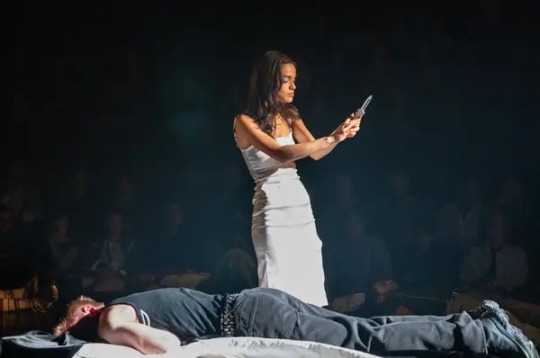
#kit connor#New York times review of Romeo + Juliet on Broadway#romeo + juliet#romeo + juliet on broadway#romeo + juliet broadway#New York Times review#romeo + juliet broadway review#new york times#romeo and juliet on broadway#New York times theater review#heartstopper#nick nelson
48 notes
·
View notes
Text

mhemusical: My first five-star review for a musical this season. See this show! It’s enchanting.” - @FeldmanAdam, @TimeOutNewYork
📷 @MurphyMade @evanzimm
#darren criss#mhe reviews#feldman adam#time out new york#maybe happy ending#maybe happy ending bway#tweets about darren#nov 2024
34 notes
·
View notes
Text

"I feel so guilty enjoying it after what Brooks Atkinson said."
Cartoon by Perry Barlow for the November 15, 1941 issue of The New Yorker. Brooks Atkinson was the theater critic of the New York Times and, even in those days when there were many more newspapers than there are now, the most powerful.
Photo: Condé Nast Store
#vintage New York#1940s#Perry Barlow#cartoon#vintage cartoon#The New Yorker#Brooks Atkinson#theater review#theater#vintage Broadway#theater criticism#1940s NYC#NY Times
19 notes
·
View notes
Note
Hello GT, I absolutely love Lionheart!
I published my first fic and have been dealing with some criticism; it’s not anythjng super hateful, but it’s not anything meant to make me improve either. I’ve been feeling sort of down because of it. My question is: have you ever dealt with hate or criticism before? What is your attitude towards it?
I find your work and answers on here super insightful and inspiring! I hope you have a nice day ❤️
Fuck em. Like, seriously, just fuck em. There's a time and place for writers to take critique and be strict with themselves; it's necessary for any artist to grow. That place is with a chosen group of creatives whose work you admire and whose judgment you trust. A rando on the Internet, while they may in fact be the next Marcel Proust, probably isn't. And I was raised to believe that while it's appropriate and kind to pay compliments to strangers when they're performing — just as you'd smile at a busker on the sidewalk, and or compliment a chalk artist — it's not appropriate to criticize them when what they do isn't to your tastes. They're providing you with their art for free. No one forced you to read it; no one forced you to listen. If you don't like it, it costs $0 to shut the fuck up.
Also — that thing I said about artists taking critique? That assumes that you're doing this out of a desire to improve your writing, which, while noble, is not actually a thing you need to do if you're a hobby writer. I like trying to improve; it makes me feel good. But at the end of the day, I do this for fun. I do this because in my real job, I am ruthless and self-critical and try really fucking hard to do well, and you need parts of your life that Aren't Like that. You need parts of your life where you're not worrying about whether you're Doing It Right. And living without that anxiety of critique is, paradoxically, the only way you'll find the artistic courage to take risks and develop new skills. Everyone is a little bit rough around the edges to begin with. (Not saying you're a beginner — you merely said "publish," and I certainly wrote a lot of things before I started publishing! But every artist is always trying to develop new skills and techniques; in the grand scope of things, we're all beginners.) Giving someone blunt critique when they're in the beginning phases of their journey as an artist is about as helpful as screaming at your six-year-old kid because he can't swim the butterfly.
And the thing is, these people will bluster and say "well, I'm just being honest, I'm just trying to be helpful," but like: mmmmmmno, you're not! You're not. And it's disingenuous to say so. Because if you were actually trying to be helpful, you would introduce yourself, offer your skills as an editor/beta reader, and start building the relationship of trust that grounds any meaningful co-creative partnership. People do not just accept random critique that comes flying at them from the blue nowhere. And issuing it in that form is the best way to make them hostile, defensive, and unreceptive to it. Delivering harsh feedback without a context of care and support is almost sure to fail as a method of actually changing behavior, and either (1) you know that, and are doing it anyway — presumably because you want people to know how Terribly Clever and Better At Writing you are, or (2) you sincerely have never thought about the effect that context and word choice have on how other people receive your meaning.
Which tells me you are the last fucking person on the planet I want writing advice from.
#basically: fuck them and fuck anyone who doesn't come to you with kindness when they're offering critique#i don't care if they're a nobel prizewinner. no one is above offering kindness#and if someone thinks they're above giving kindness then you should view them with derision and pity#imagine being so sad you spend your free time shitting on other people's art.#like you're not a critic. you're not the new york times book review buddy.#you read something that someone put their whole heart and joy and free time into#and then held out in their hands eagerly to share with you. because they thought you might like it.#and you sneered at them.#Anon I think you should keep writing forever. I think that the merest sentence you have ever written#is worth more than anything that the authors of your criticism could conceive#and it's you. it's you! if it brings you joy then it's fulfilled its purpose#people mean more than art. you mean more than art. your satisfaction is the object of making it#and finally THANK YOU so much for your very kind words.#they mean a tremendous amount and i am grateful for them.
26 notes
·
View notes
Text

Official Stick Reviews | Lindsay D'Addato | New York Times
44 notes
·
View notes
Text
Brandon Sanderson has finally become so popular that it’s cool for edgelords to hate him
#the amount of people I’ve seen saying that his books are awful recently#it’s fine to not like Brandedson!#don’t get me wrong#but a good portion of the criticism I see are giving the same vibe as the people who hated Harry Potter just because it was popular#people who think they’re reviewing him for the New York Times instead of leaving an Instagram comment lol#brandon sanderson#cosmere
67 notes
·
View notes
Link
This is an important rebuttal to the recent serious misinterpretation of data from a Cochrane review of mask use. This is a gift link, so anyone who wants to read the entire article can do so, even if they do not subscribe to The New York Times. Here is a summary of some of the problems with the studies in the review and with their interpretation:
While the review assessed 78 studies, only 10 of those focused on what happens when people wear masks versus when they don’t, and a further five looked at how effective different types of masks were at blocking transmission, usually for health care workers. The remainder involved other measures aimed at lowering transmission, like hand washing or disinfection, while a few studies also considered masks in combination with other measures. Of those 10 studies that looked at masking, the two done since the start of the Covid pandemic both found that masks helped. [emphasis added]
Below are some more highlights of the article.
Now the organization, Cochrane, says that the way it summarized the review was unclear and imprecise, and that the way some people interpreted it was wrong.
“Many commentators have claimed that a recently updated Cochrane review shows that ‘masks don’t work,’ which is an inaccurate and misleading interpretation,” Karla Soares-Weiser, the editor in chief of the Cochrane Library, said in a statement. [...] She said that “this wording was open to misinterpretation, for which we apologize,” and that Cochrane would revise the summary.
Soares-Weiser also said, though, that one of the lead authors of the review even more seriously misinterpreted its finding on masks by saying in an interview that it proved “there is just no evidence that they make any difference.” In fact, Soares-Weiser said, “that statement is not an accurate representation of what the review found.” [...] So what we learn from the Cochrane review is that, especially before the pandemic, distributing masks didn’t lead people to wear them, which is why their effect on transmission couldn’t be confidently evaluated.
[emphasis added]
[See more highlights from the article under the cut.]
To use randomized trials to study whether masks reduce a virus’s spread by keeping infected people from transmitting a pathogen, we need randomized comparisons of large groups, like having people in one city assigned to wear masks and those in another to not wear them. As ethically and logistically difficult as that might seem, there was one study during the pandemic in which masks were distributed, but not mandated, in some Bangladeshi villages and not others before masks were widely used in the country. Mask use increased to 40 percent from 10 percent over a two-month period in the villages where free masks were distributed. Researchers found an 11 percent reduction in Covid cases in the villages given surgical masks, with a 35 percent reduction for people over age 60.
Another pandemic study randomly distributed masks to people in Denmark over a month. About half the participants wore the masks as recommended. Of those assigned to wear masks, 1.8 percent became infected, compared with 2.1 percent in the no-mask group — a 14 percent reduction. But researchers could not reach a firm conclusion about whether masks were protective because there were few infections in either group and fewer than half the people assigned masks wore them. [...] Lab studies, many of which were done during the pandemic, show that masks, particularly N95 respirators, can block viral particles. Linsey Marr, an aerosol scientist who has long studied airborne viral transmission, told me even cloth masks that fit well and use appropriate materials can help.
Real-life data can be complicated by variables that aren’t controlled for, but it’s worth examining even if studying it isn’t conclusive.
Japan, which emphasized wearing masks and mitigating airborne transmission, had a remarkably low death rate in 2020 even though it did not have any shutdowns and rarely tested and traced widely outside of clusters.
David Lazer, a political scientist at Northeastern University, calculated that before vaccines were available, U.S. states without mask mandates had 30 percent higher Covid death rates than those with mandates.
Perhaps the best evidence comes from natural experiments, which study how things change after an event or intervention.
Researchers at Mass General Brigham, one of Harvard’s teaching hospital groups, found that in early 2020, before mask mandates were introduced, the infection rate among health care workers doubled every 3.6 days and rose to 21.3 percent. After universal masking was required, the rate stopped increasing, and then quickly declined to 11.4 percent.
In Germany, 401 regions introduced mask mandates at various times over three months in the spring of 2020. By carefully comparing otherwise similar places before and after mask mandates, researchers concluded that “face masks reduce the daily growth rate of reported infections by around 47 percent,” with the effect more pronounced in large cities and among older people. [...] Masks are a tool, not a talisman or a magic wand. They have a role to play when used appropriately and consistently at the right times. They should not be dismissed or demonized.
[emphasis added]
These are just some highlights from the article. I recommend using the gift link and reading the whole article. From everything I’ve read (in this article and elsewhere) high quality masks that were appropriately worn helped save lives during the pandemic. The spread of misinformation about masks by people who are politically motivated, could well lead to unnecessary deaths when the next pandemic arrives.
#covid-19#masks do help protect against infection#here's why the science is clear that masks work#the cochrane review was misinterpreted#cochrane review#zeynep tufekci#the new york times
252 notes
·
View notes
Text
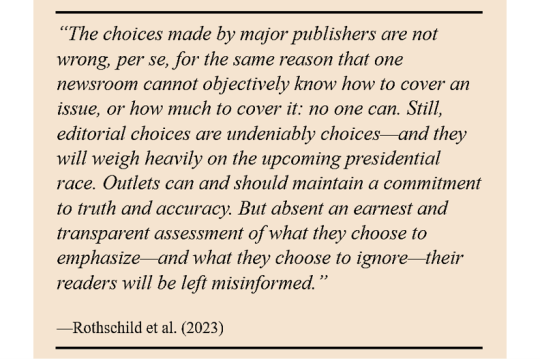
This is an excellent summary of research that was done on two major mainstream news publications--The Washington Post and The New York Times--regarding whether the content of their front pages (from Sept. 1 to Nov. 8, 2022) provided readers with information that would help them to better understand policy differences between Democrats and Republicans in the leadup to the 2022 election. Unfortunately, the study discovered that these "liberal" newspapers of record both tended to post entertaining "horse race and campaign palace intrigue" articles rather than articles discussing political party policy differences.
When these two newspapers did report on policy issues, surprisingly (especially given its liberal reputation) the Times covered more topics related to Republican interests (i.e., "China, immigration, and crime"); whereas, the Post covered more topics of greater interest to Democrats (i.e., "affirmative action, police reform, LGBTQ rights")
Below are the opening and closing paragraphs from the article, which sum up the importance of how the mainstream media shapes public perceptions of election issues--often in ways that could wittingly or unwittingly help dangerous politicians like Trump win powerful positions in our government.
Seven years ago, in the wake of the 2016 presidential election, media analysts rushed to explain Donald Trump’s victory. Misinformation was to blame, the theory went, fueled by Russian agents and carried on social networks. But as researchers, we wondered if fascination and fear over “fake news” had led people to underestimate the influence of traditional journalism outlets. After all, mainstream news organizations remain an important part of the media ecosystem—they’re widely read and watched; they help set the agenda, including on social networks. We decided to look at what had been featured on the printed front page of the New York Times in the three months leading up to Election Day. Of a hundred and fifty articles that discussed the campaign, only a handful mentioned policy; the vast majority covered horse race politics or personal scandals. Most strikingly, the Times ran ten front-page stories about Hillary Clinton’s email server. “If voters had wanted to educate themselves on issues,” we concluded, “they would not have learned much from reading the Times.” [...] The choices made by major publishers are not wrong, per se, for the same reason that one newsroom cannot objectively know how to cover an issue, or how much to cover it: no one can. Still, editorial choices are undeniably choices—and they will weigh heavily on the upcoming presidential race. Outlets can and should maintain a commitment to truth and accuracy. But absent an earnest and transparent assessment of what they choose to emphasize—and what they choose to ignore—their readers will be left misinformed. [color emphasis added]
[edited]
#mainstream media#political coverage#warped front pages#donald trump#republicans#democrats#the new york times#the washington post#columbia journalism review
72 notes
·
View notes
Text
“…the anti-anti-Trumpers, in order to justify the abandonment of their principles, are driven to poison the well of public debate for everyone else. They never expected having to deal with Trump for this long; they never foresaw themselves doubling and tripling and quadrupling down to the point where they now must politely look away from felonies, attacks on America’s alliances, and promises to pardon insurrectionists.”
Gift link: https://www.theatlantic.com/newsletters/archive/2024/08/the-conservatives-who-sold-their-souls-for-trump/679623/?gift=hVZeG3M9DnxL4CekrWGK38nWdgGJEJDaAV_aOdhRDAM&utm_source=copy-link&utm_medium=social&utm_campaign=davidaugust.com
#donald trump#trump#political#politics#us politics#USpol#gop#character#nyt#new york times#national review#journalism
13 notes
·
View notes
Photo

Cover llustrations for the New york Times Book review about the Stephen King review of "All the Sinners Bleeds" by S. A Cosby. Thank you so much AD James Blue and Alvaro Dominguez
#editorial illustration#new york times#book review#stephen king#s a cosby#pencil drawing#digital color#thriller#west virginia#small town
119 notes
·
View notes
Text
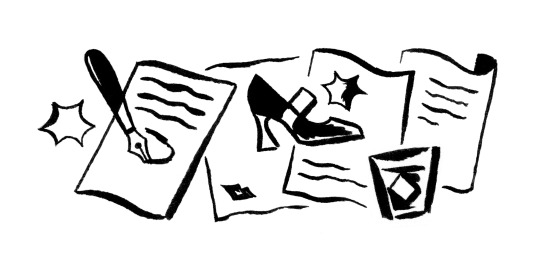
Spot for The New York Times magazine, Oct 22 2023
48 notes
·
View notes
Text
file under: me trying to sound smart
So many theatre critics missing the point: Romeo + Juliet’s superpower is in the audience they’re speaking to


Kit Connor and Rachel Zegler as Romeo and Juliet. Image source: @experienceandobservation (X)
Playbill’s notice for Romeo + Juliet reports that the director was quite purposefully speaking to young people with this Broadway revival:
Director Gold said in a statement, “With the presidential election coming up in November, I felt like making a show this fall that celebrates youth and hope, and unleashes the anger young people feel about the world they are inheriting."

Image source: Wall Street Journal’s review (X)
At least the New York Times gets it:
The reconsidered tone of this Shakespeare adaptation, aimed squarely at the young people who packed the house, was praised by the New York Times theatre critic as worthy. Thankfully that’s an incredibly influential theatre critic from one of the most important publications for Broadway reviews.
In stark contrast, the New York Post and Variety theatre critics couldn’t see past the past. They appeared to want a traditional take on the Bard’s most tragic love story, which completely misses the point.
#kit connor#romeo + juliet#romeo + juliet broadway review#romeo + juliet on broadway#romeo + juliet broadway#romeo and juliet on broadway#romeo & juliet#romeo and juliet#mine#pin#pinned#review#new york times#Broadway review#new york post#variety magazine
21 notes
·
View notes
Text

Via Brandon Schwartz's Instagram Story (November 15th, 2024)
#darren criss#brandon schwartz#the new york times#mhe reviews#maybe happy ending#maybe happy ending bway#instagram#nov 2024
35 notes
·
View notes
Text

good morning guys my fic got a new york times review i think ive officially made it into the big leagues
#ray's tag#described#ao3#this one made me laugh out loud while i was checking my email this morning ALSKAKSK#i know this isnt real but i respect the dedication to the bit. thank you american newspaper the new york times for leaving#a favorable review on my empires smp crackfic 🙏🙏🙏
36 notes
·
View notes